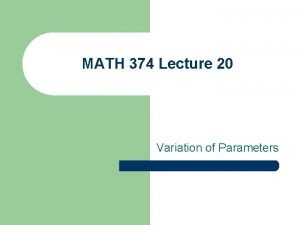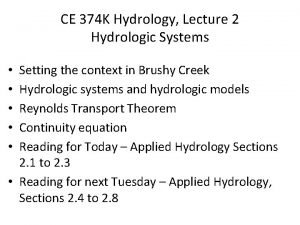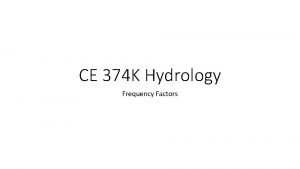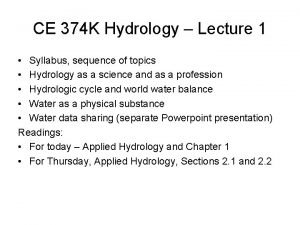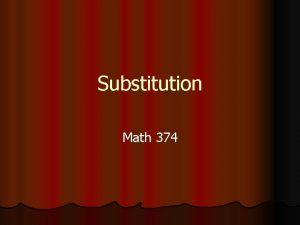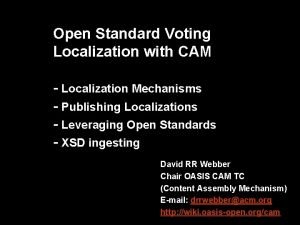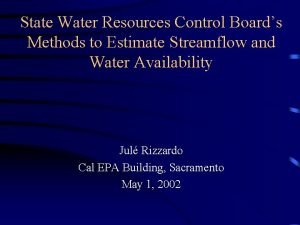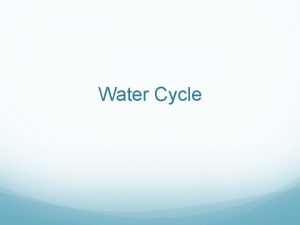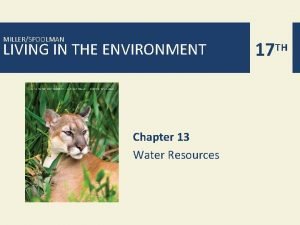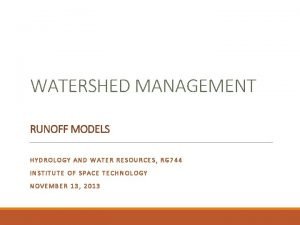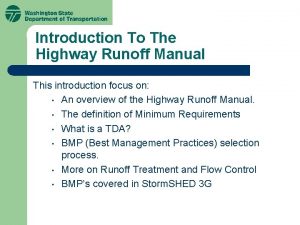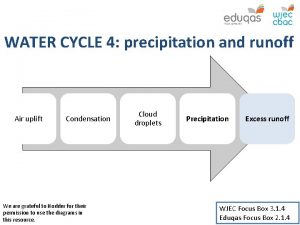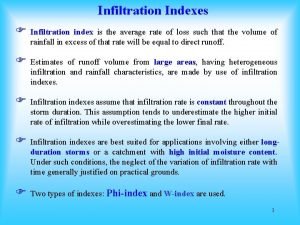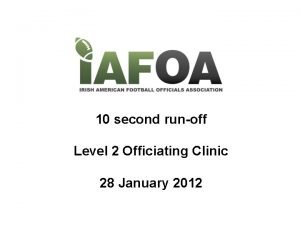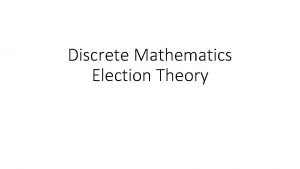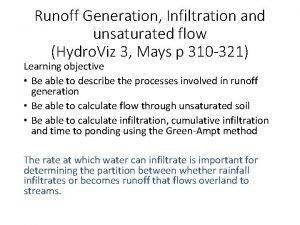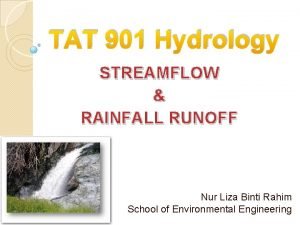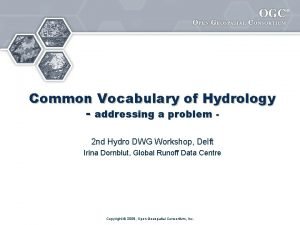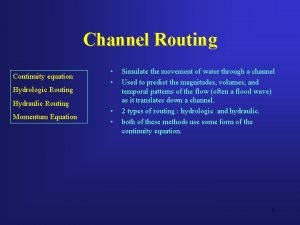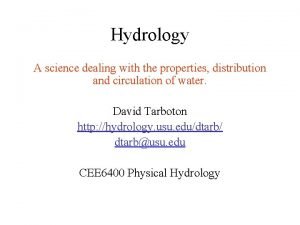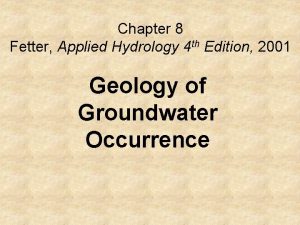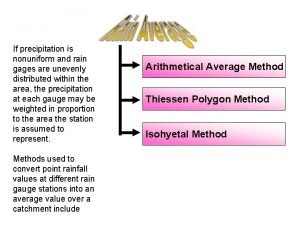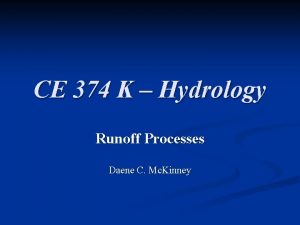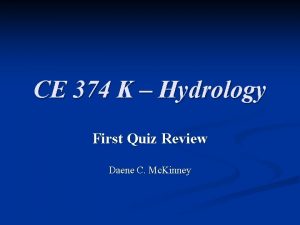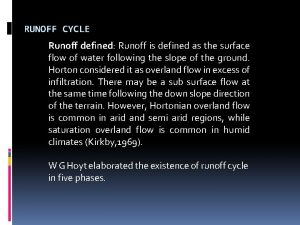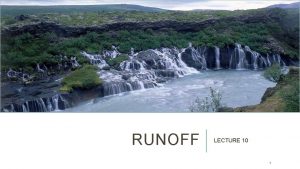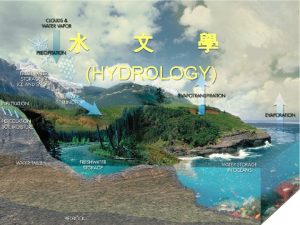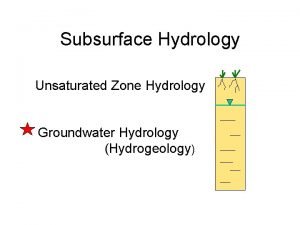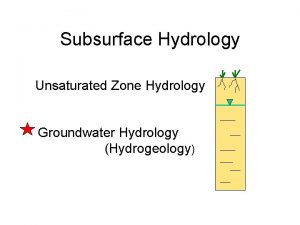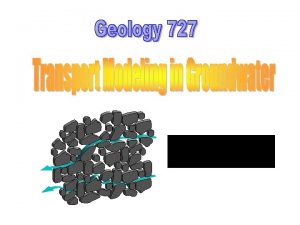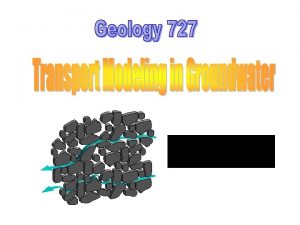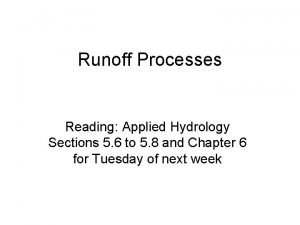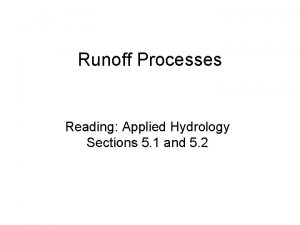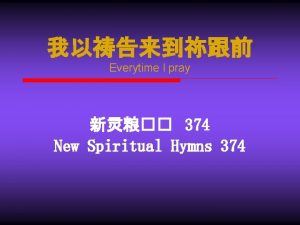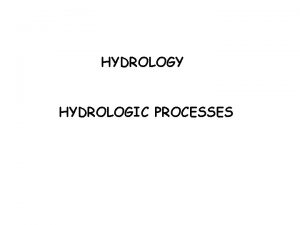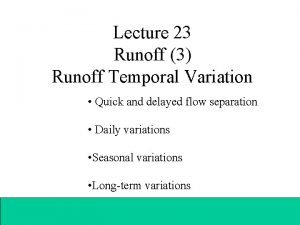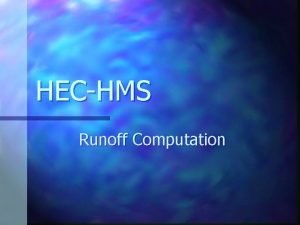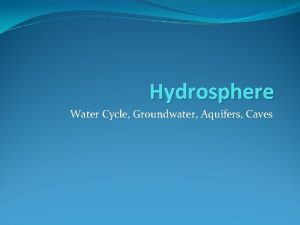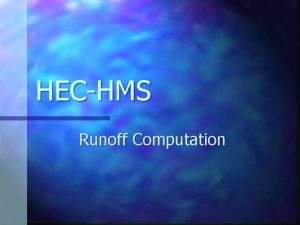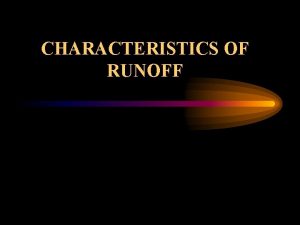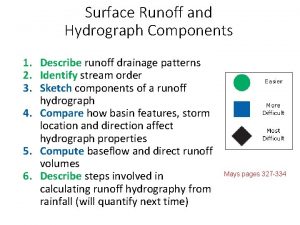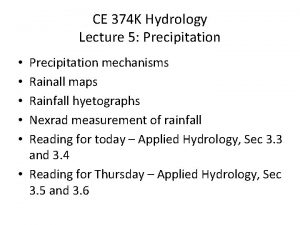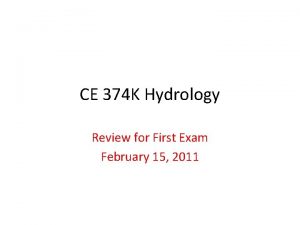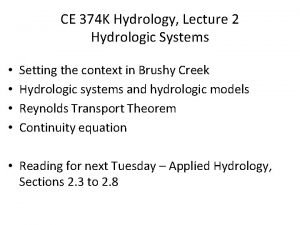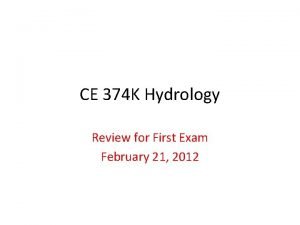CE 374 K Hydrology Runoff Processes Daene C




























- Slides: 28

CE 374 K – Hydrology Runoff Processes Daene C. Mc. Kinney

Watershed n n n Area draining to a stream Streamflow generated by water entering surface channels Affected by n n Physical, vegetative, and climatic features Geologic considerations Stream Patterns Dry periods n Flow sustained from groundwater (baseflow) http: //www. epa. gov/owow/watershed/whatis. html

Streamflow Atmospheric Moisture n Atmospheric Water n n n Subsurface Water n n n Evapotranspiration Precipitation Infiltration Groundwater Surface Water Snow Rain Evaporation Interception Energy Throughfall and Stem Flow Snowpack Snowmelt Pervious Surface Infiltration Soil Moisture Percolation Groundwater Evapotranspiration Overland Flow Groundwater Flow Streams and Lakes Channel Flow Runoff Watershed Boundary Impervious Evaporation

Streamflow Hydrograph Basin Lag Centroid of Precipitation g Lim Risin Discharge, Q b im n. L sio ces Re Time of Rise b Peak Inflection Point Baseflow Recession Beginning of Direct Runoff End of Direct Runoff Time

n n No inflow added to groundwater - depletion (recession) curve Continuity equation Discharge, Q Baseflow Separation Baseflow Recession Time

Baseflow Separation Techniques Straight – line method n Draw a horizontal line segment (A-B) from beginning of runoff to intersection with recession curve Discharge, Q n Direct Runoff B A Baseflow Time

Baseflow Separation Techniques Fixed Base Method n n Draw line segment (A – C) from baseflow recession to a point directly below the hydrograph peak Draw line segment (C-D) connecting a point N time periods after the peak Discharge, Q n Direct Runoff A C Baseflow D B Time

Baseflow Separation Techniques Variable Slope Method n n n Draw line segment (A-C) forward from baseflow recession to a point directly below the hydrograph peak Draw line segment (B-E) backward from baseflow recession to a point directly below the inflection point Draw line segment (C-E) Discharge, Q n A Direct Runoff E C Baseflow B Time

Abstraction (Losses) Estimation Phi – Index Method n Excess (effective) rainfall n n Abstraction (losses) n n Rainfall that is not retained or infiltrated Becomes direct runoff Excess rainfall hyetograph (excess rainfall vs time) Difference between total and excess rainfall hyetographs Phi – Index n Constant rate of abstraction yielding excess rainfall hyetograph with depth equal to depth of direct runoff

Example Time Have precipitation and streamflow data, need to estimate losses Observed Rain Flow in cfs 8: 30 203 9: 00 0. 15 246 9: 30 0. 26 283 10: 00 1. 33 828 10: 30 2. 2 2323 11: 00 0. 2 5697 11: 30 0. 09 9531 12: 00 11025 12: 30 8234 1: 00 4321 1: 30 2246 2: 00 1802 2: 30 1230 3: 00 713 3: 30 394 4: 00 354 4: 30 303 No direct runoff until after 9: 30 And little precip after 11: 00 Basin area A = 7. 03 mi 2

Example (Cont. ) n Estimate baseflow (straight line method) n Constant = 400 cfs baseflow

Example (Cont. ) n Calculate Direct Runoff Hydrograph n Subtract 400 cfs Total = 43, 550 cfs

Example (Cont. ) n Compute volume of direct runoff n Compute depth of direct runoff

Example (Cont. ) n n Neglect all precipitation intervals that occur before the onset of direct runoff (before 9: 30) Select Rm as the precipitation values in the 1. 5 hour period from 10: 00 – 11: 30

Example (Cont. ) f. Dt=0. 27

SCS Curve Number Method n n n Soil Conservation Service(SCS) Curve Number (CN) model estimates precipitation excess as a function of cumulative precipitation, soil cover, land use, and antecedent moisture SCS developed the method for small basins (< 400 sq. mi. ) to "before" and "after" hydrologic response from events. Classify soils (60 or 70 types) into four hydrologic soil groups Method is simple enough to be used by people that have little experience with hydrology. Converts basin storage into something simpler and more manageable (a “curve number” CN)

n In general n After runoff begins n Potential runoff n SCS Assumption Precipitation Abstractions – SCS Method Time n Solve for Rainfall Excess

SCS Method (Cont. ) n Surface n n n Experiments showed n So Impervious: CN = 100 Natural: CN < 100

SCS Method (Cont. ) n S and CN depend on antecedent rainfall conditions Normal conditions, AMC(II) Dry conditions, AMC(I) n Wet conditions, AMC(III) n n 5 -day antecedent rainfall (in) AMC Group Dormant season Growing season I < 0. 50 < 1. 4 II 0. 5 -- 1. 1 1. 4 – 2. 1 III > 1. 1 > 2. 1

SCS Method (Cont. ) n SCS Curve Numbers depend on soil conditions Group Minimum Infiltration Rate (in/hr) Soil type A 0. 3 – 0. 45 High infiltration rates. Deep, well drained sands and gravels B 0. 15 – 0. 30 Moderate infiltration rates. Moderately deep, moderately well drained soils with moderately coarse textures C 0. 05 – 0. 15 Slow infiltration rates. Soils with layers, or soils with moderately fine textures D 0. 00 – 0. 05 Very slow infiltration rates. Clayey soils, high water table, or shallow impervious layer

Example - SCS Method - 1 n n n Rainfall: 5 in. Area: 1000 -ac Soils: n n Class B: 50% Class C: 50% Antecedent moisture: AMC(II) Land use n Residential n n Paved roads: 18% with curbs and storm sewers Open land: 16% n n n 40% with 30% impervious cover 12% with 65% impervious cover 50% fair grass cover 50% good grass cover Parking lots, etc. : 14%

Example (SCS Method – 1, Cont. ) Hydrologic Soil Group B C Land use % CN Product Residential (30% imp cover) 20 72 14. 40 20 81 16. 20 Residential (65% imp cover) 6 85 5. 10 6 90 5. 40 Roads 9 98 8. 82 Open land: good cover 4 61 2. 44 4 74 2. 96 Open land: Fair cover 4 69 2. 76 4 79 3. 16 Parking lots, etc 7 98 6. 86 40. 38 50 Total 50 43. 40

Example (SCS Method – 1 Cont. ) n Average AMC n Wet AMC

Example (SCS Method – 2) n n Given P, CN = 80, AMC(II) Find: Cumulative abstractions and excess rainfall hyetograph Time (hr) Cumulativ e Rainfall (in) P 0 0 1 0. 2 2 0. 9 3 1. 27 4 2. 31 5 4. 65 6 5. 29 7 5. 36 Cumulative Abstractions (in) Ia Fa Cumulative Excess Rainfall (in) Pe Excess Rainfall Hyetograph (in)

Example (SCS Method – 2) Time (hr) Cumulative Rainfall (in) P n n n Calculate storage Calculate initial abstraction Initial abstraction removes n n n 0. 2 in. in 1 st period (all the precip) 0. 3 in. in the 2 nd period (only part of the precip) Calculate continuing abstraction 0 0 1 0. 2 2 0. 9 3 1. 27 4 2. 31 5 4. 65 6 5. 29 7 5. 36

Example (SCS method – 2) Time (hr) n Cumulativ e Rainfall (in) Cumulative Abstractions (in) P Ia Fa 0 0 0 - 1 0. 2 - 2 0. 9 0. 5 0. 34 3 1. 27 0. 59 4 2. 31 0. 5 1. 05 5 4. 65 0. 5 1. 56 6 5. 29 0. 5 1. 64 7 5. 36 0. 5 1. 65 Cumulative abstractions can now be calculated

Example (SCS method – 2) Time (hr) Cumulative Rainfall (in) Cumulative Abstractions (in) Cumulative Excess Rainfall (in) P Ia Fa Pe 0 0 0 - 0 0 1 0. 2 - 0 0 2 0. 9 0. 5 0. 34 0. 06 3 1. 27 0. 59 0. 18 0. 12 4 2. 31 0. 5 1. 05 0. 76 0. 58 2. 59 can now be calculated Cumulative excess 0. 5 rainfall 1. 56 6 5. 29 0. 5 1. 64 3. 15 n Excess Rainfall Hyetograph can be calculated n Excess Rainfall Hyetograph (in) 5 4. 65 Cumulative 7 5. 36 0. 5 1. 65 3. 21 1. 83 0. 56 0. 06

Time of Concentration Different areas of a watershed contribute to runoff at different times after precipitation begins n Time of concentration n Time at which all parts of the watershed begin contributing to the runoff from the basin n Time of flow from the farthest point in the watershed n
 Math 374
Math 374 Ece374
Ece374 Ce 374
Ce 374 380 en yakın yüzlüğe yuvarlama
380 en yakın yüzlüğe yuvarlama Ce 374
Ce 374 Ce 374
Ce 374 Cse 374
Cse 374 Math 374
Math 374 Nrsg 374 assignment 1
Nrsg 374 assignment 1 Concurrent processes are processes that
Concurrent processes are processes that Instant runoff voting excel template
Instant runoff voting excel template Runoff coefficient
Runoff coefficient Runoff water cycle
Runoff water cycle How to prevent soil runoff on a slope
How to prevent soil runoff on a slope Qp formula
Qp formula Highway runoff manual
Highway runoff manual Runoff
Runoff Scs cn method of runoff estimation
Scs cn method of runoff estimation 10 second run off
10 second run off What is a runoff sentence
What is a runoff sentence Sequential runoff example
Sequential runoff example Runoff generation
Runoff generation Khosla formula for runoff
Khosla formula for runoff Factors affecting runoff
Factors affecting runoff International glossary of hydrology
International glossary of hydrology Continuity equation hydrology
Continuity equation hydrology Hydrology is science which deals with
Hydrology is science which deals with Applied hydrology
Applied hydrology Arithmetic mean rainfall
Arithmetic mean rainfall
